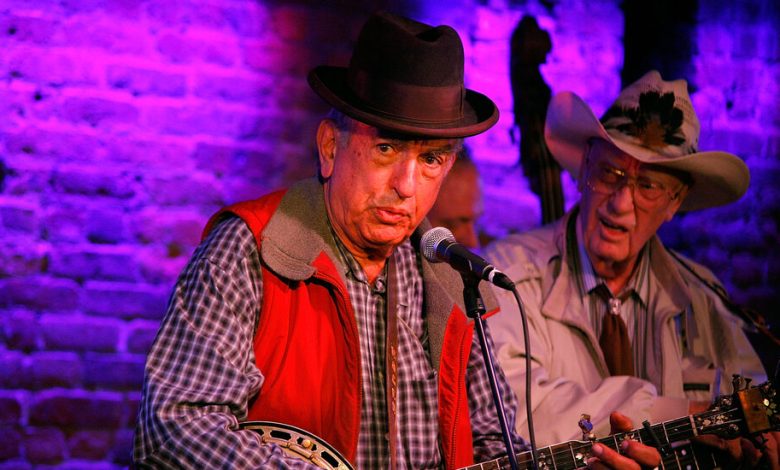Roger Sprung, Banjo Virtuoso of N.Y.C. Folk Scene, Dies at 92

Roger Sprung, a banjo virtuoso and key figure in New York’s midcentury folk music revival, whose innovative picking and genre-mashing audacity earned him the unofficial title of the godfather of progressive bluegrass, died on July 22 at his home in Newtown, Conn. He was 92.
His death was confirmed by his wife, Nancy Sprung.
A New York City native who honed his skills early on by playing mountain music festivals in Virginia and the Carolinas, Mr. Sprung began his career in the parks and folk clubs in and around Greenwich Village and went on to become an inspiration for the modern bluegrass known as newgrass.
In the late 1950s, he played with a folk trio, the Shanty Boys, who recorded for Elektra Records. He later performed at Carnegie Hall and Lincoln Center and made appearances on television in the 1960s backing the popular country and pop singer Kay Starr on programs like “The Jimmy Dean Show.”
In 2020, Mr. Sprung was inducted into the American Banjo Museum Hall of Fame in Oklahoma City, which cites the Kingston Trio and Béla Fleck as having been influenced by him. Steve Martin, another Hall of Fame member whose banjo prowess was a cornerstone of his early comedy act, has owned a Gibson RB-18 five-string that once belonged to Mr. Sprung.
“An argument could be made that Roger Sprung was the first progressive five-string banjoist,” Johnny Baier, the museum’s executive director, wrote when Mr. Sprung was inducted. “While his contemporaries in bluegrass were experimenting in swing in the 1940s and ’50s, Sprung was expanding the acceptable banjo repertoire to include — in addition to swing — ragtime, pop and classical styles as well.”
To Mr. Sprung, musical styles existed to be cross-pollinated.
“People say, ‘Do you play bluegrass?’ — and they expect ‘Roll in My Sweet Baby’s Arms’ and things like that,” he said in a 2006 video interview. “But bluegrass is an instrumentation, and if you do the instrumentation, you can play anything. I got Mozart, I got rags — ‘Maple Leaf Rag,’ Scott Joplin.”
In 1970, Mr. Sprung was proclaimed the World’s Champion Banjo Player at the Union Grove Old Time Fiddlers’ Convention in North Carolina. That same year, he drew a rave review from John S. Wilson of The New York Times for a New York concert, backed by the Progressive Bluegrassers, which included a longtime collaborator, the guitarist and singer Hal Wylie.
Venturing into a “high register to get sound that resembles a mandolin,” Mr. Wilson wrote, Mr. Sprung “made an interesting use of glissandos, produced by twisting the string pegs, particularly in a schottische” — a traditional country dance — “that required a Hawaiian guitar effect.”
Roger Howard Sprung was bornon Aug. 29, 1930, in New York City, the younger of two sons of Sam and Ethel Sprung. His father was a lawyer. Roger took piano lessons while growing up on the Upper West Side of Manhattan and was soon laying down boogie-woogie numbers.
His musical direction changed one Sunday in 1947, when his brother, George, took him to hear a group of folk musicians jamming in Washington Square Park in Greenwich Village. Before long he bought a banjo and began learning bluegrass picking by slowing down 78-r.p.m. records featuring Earl Scruggs, essentially the king of bluegrass banjo.
Mr. Sprung was 20 when he began his annual pilgrimages to the South, where he steeped himself in old-time banjo techniques while playing festivals with the likes of Samantha Bumgarner, a celebrated mountain music banjo player.
He also became skilled in the traditional clawhammer banjo style, which involves playing with the back of a finger and a thumb, as opposed to bluegrass style, which employs picks worn on the index and middle fingers and the thumb.
He brought those rustic sounds back to his bustling hometown and was eventually credited with helping to introduce Southern bluegrass to New York’s flourishing folk scene. At nearly 6-foot-3-inches tall, with his colorful personality and trademark homburg hat, Mr. Sprung was suddenly an attraction.
“I went to Washington Square every Sunday, weather permitting, and the crowd got bigger and bigger,” he said in a 2021 video interview with the American Banjo Museum.
He soon joined Ms. Starr on tour, and his career was on its way. He formed his first band, the Folksay Trio, in about 1954. In 1963, he released the album “Progressive Bluegrass 1 and Other Instrumentals,” on the Folkways label, with the flat-picking bluegrass guitar master Doc Watson. He also recorded two albums with his first wife, Joan Sprung, whom he divorced in 1972.
Along the way, Mr. Sprung was a sought-after banjo instructor. His students included the singer-songwriter Harry Chapin.
In addition to his second wife, Nancy, Mr. Sprung is survived by his daughters Jennie and Emily.
Though he had made his living off the banjo, Mr. Sprung said later in life that he would not advise younger players to follow in his footsteps. “I wouldn’t make it a career, but playing a banjo is real enjoyment,” he said, adding, “As Kay Starr said, ‘It’s hard to play a sad song on a banjo.’”



